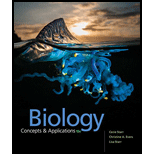
Biology: Concepts and Applications (MindTap Course List)
10th Edition
ISBN: 9781305967335
Author: Cecie Starr, Christine Evers, Lisa Starr
Publisher: Cengage Learning
expand_more
expand_more
format_list_bulleted
Concept explainers
Question
Chapter 22, Problem 10SA
Summary Introduction
Introduction:
The organisms are classified into two types. These are prokaryotes and eukaryotes. Prokaryotes are the organisms that do not contain a well-defined nucleus. However, eukaryotes have a well-defined nucleus properly enclosed in a nuclear membrane. There are different types of
Expert Solution & Answer
Want to see the full answer?
Check out a sample textbook solution
Students have asked these similar questions
The yeasts whose fermentation activity produces thecarbon dioxide that makes bread rise are a .a. chytrid c. sac fungusb. zygote fungus d. club fungus
_____are fungi that live as intracellular parasites. a. Glomeromycetes c. Microsporidia b. Chytrids d. Club fungi
In most_______ , an extensive dikaryotic mycelium is the longest-lived phase of the life cycle. a. chytrids c. sac fungi b. zygote fungi d. club fungi
Chapter 22 Solutions
Biology: Concepts and Applications (MindTap Course List)
Knowledge Booster
Learn more about
Need a deep-dive on the concept behind this application? Look no further. Learn more about this topic, biology and related others by exploring similar questions and additional content below.Similar questions
- Actinomycetes are ___________ that cause _________ .a. filamentous rods, chronic granuloma infectionsb. pleomorphic bacteria, erysipeloidc. sporeformers, tooth decayd. hyphae, pseudomembranesarrow_forwardFungal infections are most common in______ . a. plants c. mammals b. insects d. birdsarrow_forwardWhich fungus does not commonly cause systemic infection?a. Blastomyces b. Cryptococcusc. Histoplasma d. Malasseziaarrow_forward
- Mycelium is a mass of conidia. A. True B. Falsearrow_forwardA scientist is interested in genetically engineering a fungus to hinder its reproductive process so that it does not spread fast. Which process should be disrupted to hinder fungal reproduction? A. Mycelium formation B. Nutrient absorption C. Septa formation D. Spore formation E. None of thesearrow_forwardPsitticosis is a _________infection associated with ___________- .a. rickettsial, parrots b. chlamydial, mice c. chlamydial, birds d. rickettsial, fliesarrow_forward
- The mycelium of a multicelled fungus is a mesh of filaments, each called a_______ . a. septa b. hypha c. sporearrow_forwardGiardia is a/an ___________ that invades the ___________ .a. flagellate, large intestine b. amoeba, small intestine c. ciliate, large intestined. flagellate, small intestinearrow_forwardYou are given a fungus to identify. It has a fruiting body that contains many structures with eight haploid spores lined up in a row. What kind of fungus is this? A. zygomycete B. chytrid C. deutromycete D. ascomycete E. glomeromycete It is not Darrow_forward
- Dinoflagellates and provide nutrients from the products of photosynthesis to the corals in exchange for a safe place to live, the best description of this symbiotic relationship is A. mutualistic B. parasitic C. commensalarrow_forwardMatch the terms appropriately.___ club fungus a. first discovered in a___ chitin soil-dwelling sac fungus___ penicillin b. component of fungal___ sac fungus cell walls___ zygote fungus c. partnership between a___ lichen fungus and one or more___ mycorrhiza photoautotrophs___ hypha d. basidocarp producer___ ringworm e. fungus–plant partnership f. forms sexual spores in an ascus g. bread mold is an example h. fungal skin disease i. strand of many cells arranged end to endarrow_forwardWhich phase of a fungal life cycle is best adapted to growing in ahost’s body?a. yeast b. hyphal c. conidial d. filamentousarrow_forward
arrow_back_ios
SEE MORE QUESTIONS
arrow_forward_ios
Recommended textbooks for you

 Concepts of BiologyBiologyISBN:9781938168116Author:Samantha Fowler, Rebecca Roush, James WisePublisher:OpenStax College
Concepts of BiologyBiologyISBN:9781938168116Author:Samantha Fowler, Rebecca Roush, James WisePublisher:OpenStax College


Concepts of Biology
Biology
ISBN:9781938168116
Author:Samantha Fowler, Rebecca Roush, James Wise
Publisher:OpenStax College
Soil Ecology; Author: Prof. Mark Valen;https://www.youtube.com/watch?v=rByV6yvJ-Ho;License: Standard youtube license